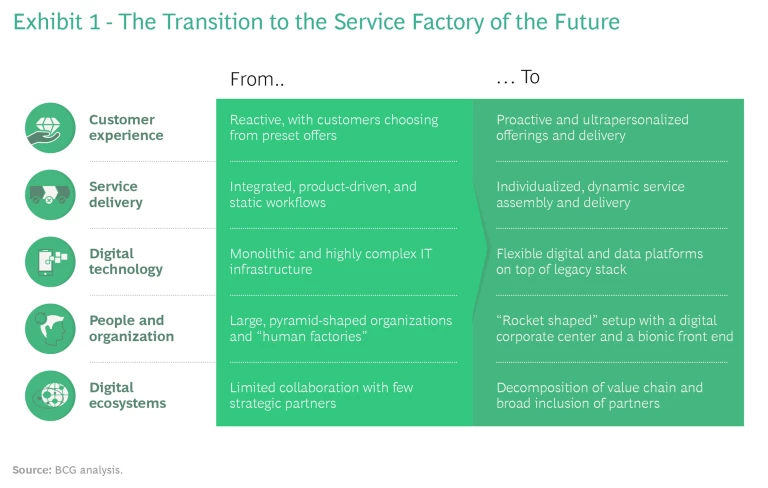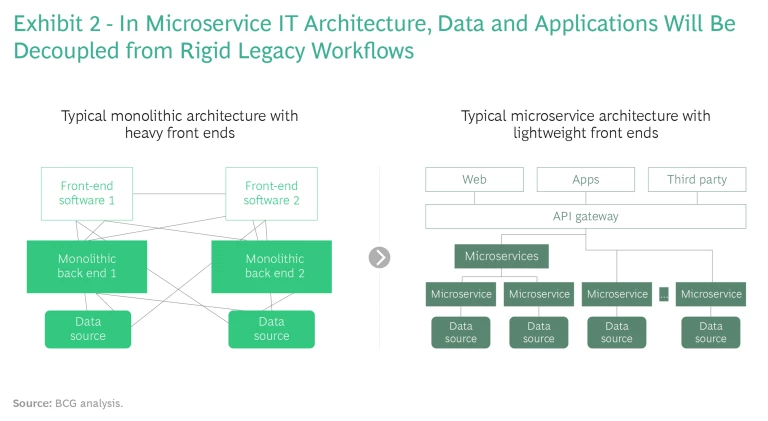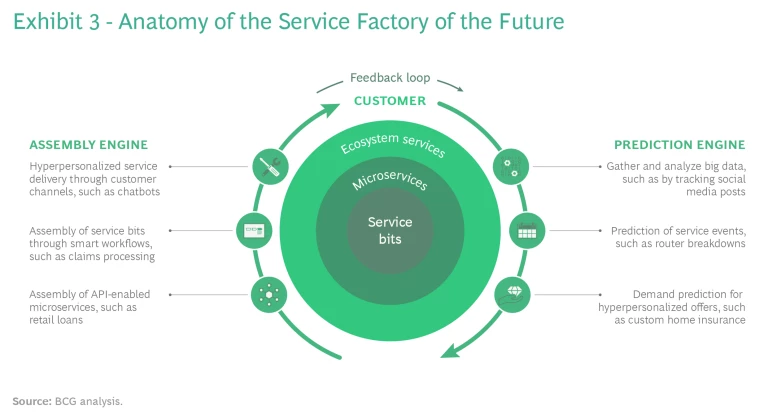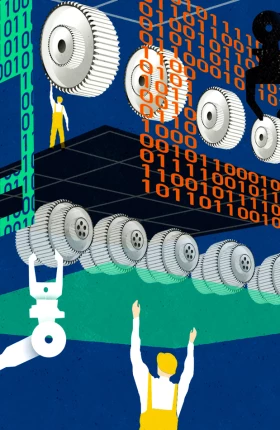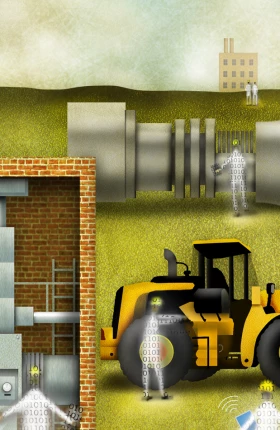Imagine a world where you never have to try frantically to get through to customer service when your internet service goes down and then struggle to troubleshoot over the phone. Instead, the provider calls you to take preemptive action—or fixes the problem before you even know you have one. And when you are shopping for a service provider, the telecom company uses available data to recommend a bundle tailored to your family’s needs and budget, so you don’t have to wade through complex combinations of pricing, service, data usage, and device options.
Over the coming decade, this vision will become a reality. Sectors as diverse as finance, transportation, energy, and telecommunications are beginning a transformation not unlike manufacturing’s adoption of Industry 4.0 technologies. Today’s service factory—with its mass production of commodity products, giant call centers, and rigidly standardized processes and scripts for dealing with everything from customer inquiries and technical support to after-sales service—will be replaced by dispersed, minimalist workforces of highly skilled specialists collaborating with digital technologies and tools, such as artificial intellgence, advanced robotics, blockchain, and predictive data analytics. These The Bionic Company will be able to anticipate, assemble, and deliver hyperpersonalized and ultraindustrialized offerings in real time based on modular “service bits” that can be mixed and matched like Lego bricks.
Digitally native service companies such as Amazon, Alibaba, Tencent, Expedia, and Uber already are well along on this journey; incumbent service providers like Lloyds Bank, Telstra, and Starbucks have also begun the transition. These early adopters are providing highly personalized experiences on the back of adaptive and cost-efficient microservice and IT architectures based on application programming interfaces (APIs).
The full transition to the service factory of the future entails a massive transformation that could take five to ten years. But in nearly every sector, competition is intensifying from disruptive, digitally native entrants. So the time to start is now.
The Traditional Service Factory Is On Its Way Out
To get a sense of how far service industries still must travel, consider the revolutionary changes that are transforming manufacturing. Most leading automakers, for example, long ago adopted modular assembly methods that enable them to customize at mass efficiency using different combinations of standardized components. Tesla has taken the concept further with connected cars that allow owners to modify their autopilot systems, battery life, and other features by downloading over-the-air software updates. Industry 4.0 manufacturing systems—autonomous robots, 3-D printing, and digital simulation, among other tools—are enabling producers of everything from athletic shoes to aircraft components to shift from mass production to mass customization and from giant factories concentrated in a few low-cost countries to smaller, more flexible facilities dispersed in locations closer to end customers.
Today’s service factory will be replaced by dispersed, minimalist workforces of highly skilled specialists collaborating with digital technologies and tools.
By contrast, most service organizations remain anchored to older industrial models. Starting in the 1980s, airlines, insurers, health care providers, credit card companies, and other enterprises began outsourcing labor-intensive back-office work to shared-services providers—at first close to home and then increasingly offshore—to cut costs and improve efficiency. In most sectors, this workbench extension was about as far as the transformation got. The majority of large service enterprises still use traditional factory layouts that rely on large numbers of people following workflows that are hardwired into legacy IT systems.
While the traditional service factory works well in terms of reducing costs and enabling service companies to scale up, it has always had limitations. Telecom customers have had to endure long waits for repairs and bank customers long waits for loans to be approved and disbursed. When filing insurance claims, customers often must fill out lengthy forms by hand that ask for personal data their insurers already have, submit extensive documentation, and wait months for reimbursement.
Constrained by their factory model and by poor IT architecture, many providers have simply accepted these tradeoffs between cost efficiency and quality and offered two tiers of service: mediocre quality and standardized offerings for the general public and highly attentive service and customized solutions for preferred customers or those willing to pay a premium. But this approach is not adequate to meet customer expectations in today’s highly contested services markets. Leading-edge providers are moving to both hyperpersonalization and ultraindustrialization. They are aspiring to deliver services that can be adapted to the evolving tastes, interests, and immediate needs of individual consumers at mass efficiency.
As the global economy recovers from the COVID-19 crisis, the challenging business environment will further increase the pressure to cut costs, deliver services in ways that build resilience against future shocks, and meet customer expectations for more personalized and enjoyable service. The current situation may even trigger greater acceptance by customers and employees of an accelerated introduction of digital technologies.
Anatomy of the Service Factory of the Future
The service factory of the future will break the compromise between personalization and industrialization by leveraging standard service bits: small elements of service, such as a chatbot or an online shopping cart. Service bits will increasingly consist of “microservices”—digitized service offerings or processes—that are accessed through APIs and either created in-house or procured from ecosystem partners. Bits can also be automated or manual service activities based on legacy IT systems. By flexibly combining service bits, the service factory of the future will be able to create hyperpersonalized offerings and packages tailored to an individual’s needs, preferences, and habits on the basis of a wide range of customer data .
Migration to the service factory of the future requires transformative change in five critical dimensions: customer experience, service delivery, digital technology, people and organization, and digital ecosystems. (See Exhibit 1.)
Customer Experience
Most service providers currently operate in a reactive way. They wait for customers to articulate their needs and then respond by offering a range of preset offerings with different levels of service. The service factory of the future will enable providers to be predictive, preventive, and proactive. It will anticipate customers’ needs and approach them with solutions and hyperpersonalized experiences. More important, it will develop capabilities to prevent service lapses from occurring in the first place. Telcos, for instance, will be able to use predictive network maintenance to identify network issues before they occur. Leading insurance companies have already launched digital services that provide early warnings aimed at preventing property loss and casualty.
The service factory of the future will also enable companies to leverage new AI-powered tools that can recognize customer emotions and personality traits to provide context-based offerings. General Motors has demonstrated its interest in deploying facial recognition to pick up emotional signals, for example, by installing interactive billboards in public spaces in which an “actor” presenting a car responds differently to viewers depending on their age, sex, facial expressions, movements, and reactions. A company could customize the experience by combining such recognition tools with its own data from previous customer touchpoints and with information gleaned from the internet. Does a particular customer prefer to engage with a sales agent who straightforwardly presents the facts, for example, or with one who conveys empathy? With someone who is younger or someone older?
Service Delivery
Automated “smart” workflows that retrieve the right information and select the right combinations of microservices for the customer will replace rigid workflows offering standard products. These smart workflows will continuously improve and become more efficient through machine learning that allows for individualized and real-time rearrangement of microservices.
These capabilities do not fully exist yet. But the digital tools are coming. Germany’s Celonis, for example, offers a “process mining” solution that creates full process transparency, identifies bottlenecks, and highlights optimization potential in processes such as customer service, order to cash, and production planning. The company’s Intelligent Business Cloud analyzes and visualizes the event data captured in underlying IT systems such as SAP to overcome process inefficiencies. Algorithms, meanwhile, are getting better at making decisions that have always required human judgment. Austin, Texas-based, Turnkey Lender, for example, offers enterprise software whose machine-learning algorithms evaluate the risk profiles of borrowers by accessing and analyzing more data—such as payment history—than lending officers usually use to make decisions. Turnkey Lender’s algorithms also speed up the loan processing and approval process.
To get a sense of how service delivery can change, consider a typical insurance company. A service factory of the future will retrieve all the necessary information from its own and from outside sources and process claims quickly. For instance, it might inspect flood or hurricane damage to a home from drone images and begin the claim process proactively. What’s more, by accessing data on customers’ homes, vehicles, and medical status, the insurer will be able to recognize and anticipate their insurance needs and offer full, custom packages of services—and alter those offerings in response to life events, such as the birth of a child or a move to a different city.
Digital Technology
In the legacy IT environment of most large enterprises, data storage and consumption are still largely fragmented, siloed, and redundant across functions such as sales and marketing, customer operations, and billing. Moreover, front-end software that contains data inputs from users and covers much of the business logic is often integrated with monolithic, and partly outdated or obsolete, back-end information technology. (See Exhibit 2.) That makes it difficult to retrieve and use relevant data along the customer journey. Moreover, applications are often based on thousands of lines of linear code that are hard or even impossible to modify, owing to their hard-coded linkages to other programs. As a result, workflows—such as the steps that call center agents or automated chatbots take to address technical issues or handle insurance claims—are rigidly defined and require “human glue” in the form of manual interventions.
Digitally advanced companies, such as fintechs, online travel, digital advertising, hospitality sites, and video-streaming services, have turned to an architecture in which data is decoupled from legacy system workflows. Data from across the enterprise is pooled in a data lake. An application layer draws data from this shared pool to create microservices that are capable of running independently. An e-commerce platform, for example, can build its workflow from different types of customer data records and from such microservices as account creation, online searches, shopping carts, and payment transactions. APIs connect the digitized service offerings or microservices to front-end applications that customers view through their web browsers. A travel site such as Expedia has thousands of APIs that enable customers to check flight availability, compare prices, and view hotel options.
Incumbent service providers are likewise beginning to migrate to new architectures. A leading European financial group, for example, has launched an API-enabled open banking facility that provides a single view of all its banking and insurance customers’ data. The group also aims to have a single view of its customers across all its banks in Europe, which will allow for faster payments between accounts and lower costs.
People and Organization
The service factory of the future will be organized to better reflect the ways in which technology has changed how work gets done. Enterprises need to move from pyramid structures, with huge operations staffs and business units reporting upward, to a “rocket shaped” structure with a digital corporate center at the top controlling data, setting governance policies, and providing insights that help steer the business. This structure will have fewer middle layers—and potentially none—because there will be no need for multiple levels of reporting and management. At the bottom, automated tools embedded within business unit teams will take over many transactional tasks, executing them faster and more accurately and at lower cost. At Alibaba, for example, most decisions are made by a “platform” of semiautonomous front-end teams.
Leading-edge providers are aspiring to deliver services that can be adapted to the evolving tastes, interests, and immediate needs of individual consumers at mass efficiency.
The service factory of the future will also require a different kind of workforce. The huge numbers of moderately skilled generalists housed in central facilities that today’s service factory requires for mass production and basic customer interactions will give way to automation and data, digital technologies, and customer service experts in dispersed locations. To acquire the right digital talent, traditional service enterprises will have to emulate Silicon Valley, offering incentives such as accelerated career paths and flexible work routines. Many existing staff will require training in new skills and ways of working. Such organizational changes will help keep the enterprise resilient through the tough and fast-changing business environment of the post-COVID world.
Digital Ecosystems
On its own, no company will be able to create all the microservices needed to deliver cost-efficient, best-in-class hyperpersonalized offerings. Providers will need to move from vertically integrated value chains to ones that leverage a broad and diverse ecosystem of partners and vendors.
Amazon’s Alexa digital assistant offers an early illustration of where service ecosystems are headed. Most of Alexa’s tens of thousands of “skills” are provided by a vast ecosystem of apps and service providers connected to its platform. Similarly, Expedia’s modular, one-stop travel-shopping experience is enabled by an ecosystem of more than 10,000 partners, while China’s WeChat ecosystem has enabled the app to evolve from social messaging to a microservices platform for buying and selling products, making payments, ordering food and groceries, and checking the news. To enhance the experience and engagement of customers, a leading telco formed several partnerships to launch an online platform that allows customers and employees to discuss products and services, resolve problems quickly, and share experiences.
Digital ecosystems also enable service companies to reach new markets. Uber grew by orchestrating the digital expertise of many partners through APIs, for example. Now it offers its own API that is used by airlines, Google Maps, restaurant booking services, and other partners.
The Operating Model of the Future
The transition to the service factory of the future will shift key pillars of the operating model. We predict that companies will need two distinct operating building blocks. One will be a “prediction engine” that collects and analyzes data to anticipate the needs of individual customers. (See Exhibit 3.) The prediction engine will also identify the actions required to meet those needs and recommend ways to bundle microservices into hyperpersonalized offerings. In addition, the prediction engine will gather and analyze data from legacy applications to sense, forecast, and display the status of operations in order to preempt outages and other service delivery interruptions.
The other operating building block will be an “assembly engine.” It will identify the service bits that must be assembled from an ecosystem repository of services. It will also draw from services in the company’s legacy applications. If the needed service bits are already available in the form of standardized, API-enabled microservices, highly automated service delivery will be straightforward, with little or no manual intervention required.
In most cases, however, an automated “smart” workflow will be needed to retrieve the right information and select the right combinations. We believe that many of today’s bionic services will increasingly be automated with the help of smart workflows combining process mining, machine learning, and other enabling technologies.
It will be critical that both the prediction and the assembly engines have continuous, real-time feedback loops to test and refine service solutions.
What Service Companies Can Do Now
The transformation to the service factory of the future—one that fits with a company’s strategic vision, market segment, and geographical footprint—will take years to realize. But many companies have already begun the transition. Business leaders can start by taking several actions now:
- Build demand prediction capabilities around first use cases, such as personalized upselling and retention offers, based on extended data sets and AI.
- Rationalize your services portfolio and start creating a repository of modular service bits for the assembly and delivery of future individualized offerings—including those of ecosystem partners through APIs.
- Radically simplify and standardize end-to-end processes, such as lead to cash, in order to work efficiently across customer segments and the service portfolio.
- Build zero-touch workflows that pair individual service configurations on customer front ends with the corresponding delivery paths on the back end.
- Prepare your workforce for the bionic future of service delivery. Scale up agile ways of working, digital skills, and new leadership behaviors that promote end-to-end accountability and a high-frequency test-and-learn approach.
A new era in services is dawning. The winners in the decade ahead will be those companies that embark on the journey now.
Acknowledgments
The authors are grateful for the contributions of their colleagues Martin Stefan, Kunal Goel, and Tobias Lampe.

